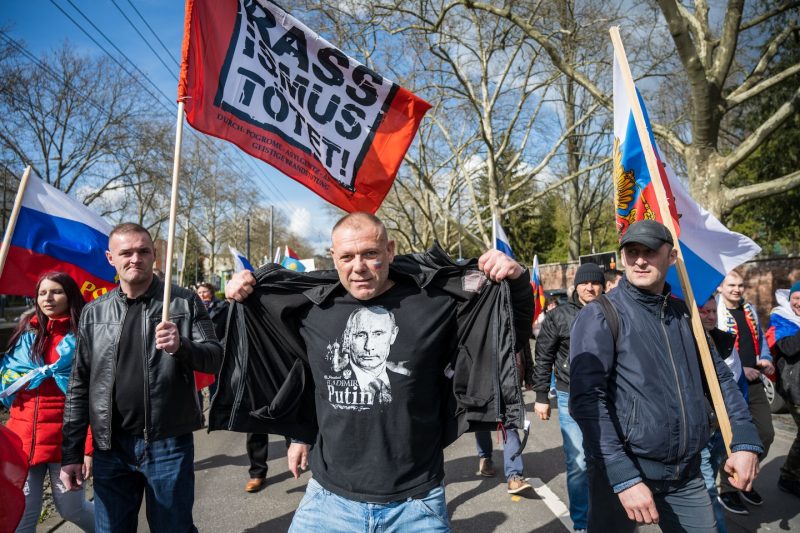Social media: Pro-Kremlin networks exploit German anger over the energy crisis to undermine support Ukraine.
The video, which featured the logo of Bild, the German tabloid, spread via a small YouTube account and the messaging app Telegram to Russian state media. It was eventually found on almost every major social media platform, as a forensic analysis later revealed.
It was a fake news report, with footage taken from unrelated events merged together to create a fake news report that casts the Ukrainian refugees as instigators who wreak havoc on the generous Germans who took them in.
As Russian forces continue their offensive shell Ukrainian citiesPro-Kremlin propagandists are now focusing on a new target: turning Europeans into terrorists the 7.8 million Ukrainian refugees who make up the continent’s largest displacement since World War II. In doing so, Russia’s disinformation merchants are needling at deep-seated European fault lines over immigration, echoing how Russia-linked operatives famously exploited major U.S. social media platformsBefore the 2016 presidential election, to sow division around race.
Experts say the propaganda campaign, which Facebook parent company Meta has called “the largest and most complex Russian-origin operation that we’ve disrupted since the beginning of the war in Ukraine,” aims to stoke fear and divisions among Ukraine’s critical European allies as they brace for a new influx of refugees this winter. Although Europeans are still supportive of fleeing Ukrainians in large numbers, there are fears that Russian efforts at weaponizing the issue may be reaching their target.
In Germany — home to more than 1 million Ukrainians — attempted arson attacks and threatening graffiti on refugee accommodations and schools in recent months suggest the messaging is already reaching a radicalized fringe. In many cases, it’s spreading via the fast-growing messaging app Telegram, which does far less content moderation than established giants such as Meta’s Facebook and Google’s YouTube.
One morning in October, at a local hotel that was converted into a refugee center run by the Red Cross in Gross Strömkendorf, a village on Germany’s north coast, someone used spray paint to turn the Red Cross sign into the shape of a bright red swastika. Two days after the swastika attack, the hotel was burned down — not by its Ukrainian inhabitants, but by a German serial arsonist, authorities say. They They say they don’t believe the fire was politically motivated. All 14 refugees escaped unharmed.
Russian disinformation “is a long-term investment, and it could become very, very toxic,” Huberta von Voss, executive director of the Germany office for the Institute for Strategic Dialogue, a London-based nonprofit that studies extremism and disinformation, said of the Russian efforts. “That can do real-world harm.”
While Europeans still support welcoming refugees strongly, support for this cause is declining in key countries. According to the Bertelsmann Foundation, the percentage of Germans who believe that Ukraine should be accepted as refugees fell from 86 per cent in March, close to the start of the war, down to 74 per cent in September.
“Lies about Ukrainian refugees and efforts to capitalize on Europeans’ fears have not successfully polarized or shaped the public discourse so far,” according to a recent European Parliament-supported studyThe Brussels-based European Policy Center. But the proportion of information that is hostile toward Ukrainian refugees “is increasing and generating greater engagement on social media,” it warned.
Russian disinformation narratives also have seeped into mainstream politics. In September, Friedrich Merz, the leader of Germany’s opposition Christian Democrats, accused Ukrainian refugees of “social tourism” — taking advantage of Germany’s welfare system while traveling back and forth to Ukraine, a narrative frequently touted by pro-Kremlin accounts. He later apologized.
There are signs that anti-refugeee propaganda is making its mark among a fringe already radicalized, who take to the streets weekly to protest against energy prices.
In one incident in the eastern city of Leipzig in October, marchers faced off against a group of Ukrainian refugees demonstrating against Russia’s bombardment. One protester called the group of Ukrainians “pigs,” adding, “You are living on our dime,” as others chanted, “Nazis out.” (Equating Ukrainians with Nazis has been a dominant theme of Russian propaganda since President Vladimir Putin sought to justify the invasion as a campaign to “de-Nazify” the country.)
Kateryna Pikalova, a 26-year-old from the Ukrainian city of Dnipro who helped organize the Ukrainian demonstration, described the scene as “chaos” but said she was not surprised. She recalled a recent incident when she and her mother, who recently arrived as a refugee, were approached by a man on the street who began comparing Ukrainians to Nazis, referring to images he’d seen online.
“You hear this on the street, and you understand that this Russian psychological operation is in action,” Pikalova said. “This Russian big machine is unstoppable, it’s everywhere. You can see it on the internet, you can feel it on the streets.”
Disinformation fault lines
The demonization and persecution of Ukrainian refugees in Germany Social media hoaxes and Experts say that bogus news stories are a particularly insidious form of disinformation. They originate from Russia. propagandists, who have long shown a knack for tapping into other countries’ Domestic political divisions are used to advance their aims.
Europe’s largest economy has been central to Moscow’s informational warfare since the Cold War, when the country was the dividing line between east and west. That is still a fault line Russian propaganda attempts to exploit, while in recent years Kremlin information operations have also focused on stirring the backlash against Germany’s decision to allow in more than a million largely Middle Eastern refugees.
Germany is a country where Russian television channels are present. According to a German Marshall Fund survey, RT DE (the German language arm of Russian state TV channel Russia Today) was the most popular social media outlet on Facebook before it was closed down by German authorities in march.
The anti-refugee narrative began as the first fleeing Ukrainians crossed the border, but took off in the spring and summer, after early attempts to justify Russia’s February invasion or play it down as a “special military operation” did not persuade Western audiences.
Whereas past waves of disinformation targeting Middle Eastern refugees portrayed them as a “cultural” threat to Europeans, the campaign against Ukrainian refugees presents them as a threat to Europeans’ health and wealth, the European Policy Center found.
Research is showing that anti-refugeet messaging was fueled by a vast, coordinated network of Russia-based fake news websites, Telegram channels and YouTube channels. Change.org petitions. And it’s being systematically amplified by armies of fake social media accounts, real pro-Kremlin influencers, and Russian state media accounts across virtually every major social platform.
It is unclear who is behind the disinformation campaign in Russia. Researchers have yet to find any direct links to Russia. It appears that the person responsible is well-resourced, experienced with disinformation campaigns, and persistent. This is a September report on the network, Facebook parent Meta said the campaign relied on “an unusual combination of sophistication and brute force.”
New research by The Institute for Strategic Dialogue shared its findings with The Washington Post before publication. It provides the most comprehensive insight into the disinformation campaign to date, focusing on the Ukrainian refugees and detailing how it worked to push specific narratives to European audiences.
The ISD report focuses on a specific Telegram channel with about 10,000 followers, called Deutsche Wahrheit (“German Truth”), as a microcosm of the broader campaign. Though the channel’s name and posts were in German, researchers noticed that the file names of the videos and clips it uploaded were often in Russian. These files contained folder names and project names similar to those found in videos posted by accounts previously identified with a pro-Kremlin propaganda channel.
Out of 219 videos posted in Deutsche Wahrheit According to the ISD, 40% of respondents mentioned refugees between April 15th-July 11th. study. Other videos sought to link Ukraine more generally to Nazism, discredit specific Ukrainian leaders, or blame Europe’s energy woes and inflation on its support of Ukraine.
Many of the posts featured faked or doctored video reports that looked like mainstream media reports. They implicated Ukrainian refugees in everything, from plotting terrorist attacks to bringing Monkeypox to Germany.
The faked clip that appeared to show Ukrainian refugees burning down their German hosts’ house in Wulfen was one of those. Its spread offers a case study in how the campaign used small, obscure accounts to seed and perhaps focus-group falsehoods that it could then spread to wider audiences, staying a step ahead of the big platforms’ content moderators.
On May 14, someone created a German-language YouTube channel with a name that translates to “News and Rumors,” according to ISD’s forensic analysis, and uploaded the faked Bild news clip. It received only 12 likes before it was deleted. YouTube didn’t respond to requests for comment.
The video was uploaded to Deutsche Wahrheit Telegram on the same day. This channel appears to have been an early or original source of many videos in the campaign. Posting on Twitter on May 17, Bild’s head of Digital, Timo Lokoschat, denounced the report as a “complete fake” — but that didn’t stop its spread. Bild didn’t respond to requests for comment.
The video began to circulate on large Russian-language Telegram channels with hundreds of thousands of subscribers by the next day. It was featured in Russian media, including Sputnik as well as the news agency RIA FAN. It spread to Chinese social media site WeiboIt was viewed hundreds and thousands of times.
Although the video was ultimately debunked, very few stories were ever corrected or removed. Telegram, Twitter, Facebook and other social media sites continued to circulate links to the articles, videos, and fake profiles with AI-generated profile pictures, amplifying them.
ZDF, a German public television network tied a series of fake news videos that purported to be from German outlets such Bild, Die Welt and Der Spiegel to a series of fake news videos. coordinated disinformation campaignAugust. ZDF observed that some fake videos were promoted on Facebook advertisements.
That triggered Meta’s investigation, which identified dozens more fake news sites and examples of disinformation targeting European audiences, primarily in Germany, and attributed the campaign to Russian origins. Meta removed all of the sites it could find. While Deutsche Wahrheit’s Instagram account survived those sweeps, Meta spokeswoman Margarita Franklin confirmed that it was part of the same campaign, and Instagram suspended it in November following The Post’s inquiries.
Such investigations have become part of Facebook’s business, and to a lesser extent those of Twitter and YouTube, since they first identified evidence of Russian interference in the 2016 U.S. elections.
But content moderation on major U.S.-based social networks has been increasing, so propagandists as well as extremists have found new outlets.
Telegram, a stateless messaging app, is one of them. It has grown to be a major communications channel in Eastern Europe. including Russia and Ukraine.
Similar anti-refugeetee disinformation campaigns linked to “hacktivism” groups in Russia and neighboring Belarus have been targeting Polish audiences, said Givi Gigitashvili, a Poland-based research associate for the nonprofit Atlantic Council’s Digital Forensic Research Lab.
Telegram spokesperson Remi Vaughn defended the company’s role in the information ecosystem. Vaughn acknowledged that Telegram has a laissez-faire approach to misinformation channels, but said that the company is expanding its fact-checking initiative. “It is our belief that the most powerful tool against misinformation is the spread of verified information,” Vaughn said.
Only about 2 million Germans subscribe to Telegram channels, Vaughn added, making it “unlikely Telegram channels could play any noticeable role in Germany’s information landscape, let alone be used as a tool for disinformation of any relevance.”
But German authorities warned the messaging app has become a “medium for radicalization,” and in October a court fined the company $5 millionFailure to comply German law regarding the reporting and capture of illegal content.
A string of incidents in recent years — including a plot to kidnap the health minister — have stoked fears that online extremism fueled by misinformation and conspiracy theories is increasingly manifesting into offline violence.
On Wednesday, German authorities arrested 25 members of what they described as a “terrorist group” suspected of plotting to storm parliament and overthrow the state by force. Prosecutors claimed that members used a variety of conspiracy theories to plot against the state and accused their leader of reaching out to Russian officials in his efforts to establish a new order for Germany.
‘The discontent of the people’
It can be difficult to pinpoint the role of Russian propaganda in domestic extremism, as foreign and domestic actors often work together, according to Pia Lamberty (CEO of CeMAS), a German think tank that tracks conspiracy theories and extremism online. “There’s a certain atmosphere created online, and this gives people the idea that they need to do something about it” — sometimes in the form of real-world hate crimes.
During the summer, graffiti in poorly spelled English reading “kill Ukrain kids” was sprayed on a school that teaches refugees in the eastern German city of Leipzig, while another kindergarten in the city attended by Ukrainians was targeted in an attempted arson. A planned home for non-Ukrainian refugees was set on fire in Bautzen (Saxony) in October.
Bild branded the hamlet of Gross Strömkendorf, situated on a picturesque inlet of the Baltic Sea, where the Red Cross refugee center was defaced and then burned to the ground, the “village of shame” in a column.
Despite more than a half a million new arrivals, attacks against refugee centers have not increased much. There were 65 people in Germany as of October. According to the German press, this year’s figures are 70 more than the 70 that were available before the Ukrainian wave. This compares to an average of around 1,000 in 2015 when more than a million mostly Middle Eastern refugees arrived in the country.
But there has been an increasingly “bad vibe” toward refugees in recent months, said Ulrike Seemann-Katz, the head of the refugee council for Mecklenburg-Vorpommern, the state where the burned down refugee center was located.
And as winter sets in, officials have said they expect an uptick in arrivals from the front lines in Ukraine, as Russian shelling inflicts severe damage to Ukrainian infrastructure — just as the impact of the energy crisis could be felt most strongly in Germany. Seeman-Katz stated that her organization has received a lot of emails asking for assistance to Germans rather than refugees.
“Sometimes it doesn’t even have to be insults — often they just make statements based on Russian propaganda,” she said.
Weekly street demonstrations in Germany have fueled anti-refugeee sentiment, according to Seeman-Katz. Regular demonstrations against coronavirus vaccinations and lockdown mandates have turned into protests about the war and high energy costs. Anti-refugeee sentiment is also on the rise.
On a Monday in late October, in Germany’s northern city of Schwerin, hundreds of demonstrators gathered at the steps of the city’s 19th-century museum next to a banner asking, “Do you want to starve or freeze?”
Attendees carried Russian and German flags, and a speaker read a supposed “testimony” from a worker in the energy industry warning of a collapse in the grid. “You may have read it already in the channels,” he began, referring to Telegram. As night fell, the crowd grew and reached several thousand.
A 64-year old retired woman wearing a string with fairy lights around her felt cap said she sees children from Ukraine who have new bicycles. “There are German children who can’t afford that,” she said. “Why does a refugee have to ride a bike? A refugee can walk.”
She complained about how state support meant that refugees could leave their windows unlocked and heat on, while pensioners struggled for money. The woman spoke on the condition of anonymity because she feared potential repercussions, and like others at the demonstration expressed a distrust of the “mainstream media.”
The retiree, who said she went to Telegram for her news, had heard about the fire at the refugee center in Gross Strömkendorf about 25 miles north, which at the time was assumed to be a targeted attack. “The fire is not okay,” said the woman, “but the discontent of the people you can understand.”
Morris also reported from Schwerin, Berlin. Oremus reported out of Newark, Del. Vanessa Guinan-Bank in Berlin and Gross Strömkendorf contributed to this report.
Source link
[Denial of responsibility! reporterbyte.com is an automatic aggregator of the all world’s media. In each content, the hyperlink to the primary source is specified. All trademarks belong to their rightful owners, all materials to their authors. If you are the owner of the content and do not want us to publish your materials, please contact us by email – reporterbyte.com The content will be deleted within 24 hours.]











